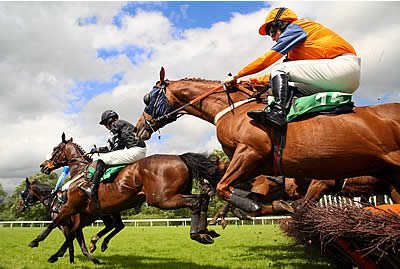The Grand National is a National Hunt horse race held annually at Aintree Racecourse in Liverpool, England. First run in 1839, it is a handicap steeplechase over 4 miles 514 yards (6.907 km) with horses jumping 30 fences over two laps. It is the most valuable jump race in Europe, with a prize fund of £1 million in 2016. An event that is prominent in British culture, the race is popular amongst many people who do not normally watch or bet on horse racing at other times of the year.
The course over which the race is run features much larger fences than those found on conventional National Hunt tracks. Many of these, particularly Becher’s Brook, The Chair and the Canal Turn, have become famous in their own right and, combined with the distance of the event, create what has been called “the ultimate test of horse and rider”.
Who will win the 2017 Randox Health Grand National? It’s the question everyone is asking, and without the aid of a crystal ball or a time machine we’re all forced to study Grand National odds to help us find the winner.
The Grand National betting market is of course the most popular of the year and once again it is looking like the National’s odds is wide open with any number of horses in with a genuine chance. Vieux Lion Rouge is a major contender for David Pipe this season. Favorite backers have found it hard to find Grand National winners in recent years but confidence is growing that Vieux Lion Rouge could become the third market leader to prevail at Aintree in the last decade.
The most recent running of the race, in 2016, was won by Rule the World, ridden by jockey David Mullins for trainer Mouse Morris. The next Grand National is on 8 April 2017.
70 horses in all will attempt to navigate the 30-fence, four mile, 514 yard steeplechase course, with the race scheduled to begin at 5:15pm BST/DST on Saturday. List of Grand National 2017 runners and riders: full list of horses and jockeys for Aintree race.
The Grand National has been broadcast live on free-to-air terrestrial television in the United Kingdom since 1960. From then until 2012 it was broadcast by the BBC. Between 2013 and 2016 it was shown by Channel 4; the UK broadcasting rights transfer to ITV from 2017. An estimated 500 to 600 million people watch the Grand National in over 140 countries. It has also been broadcast on radio since 1927; BBC Radio held exclusive rights until 2013; however, Talksport also now holds radio commentary rights.
The Grand National is run over the National Course at Aintree and consists of two laps of 16 fences, the first 14 of which are jumped twice. Horses completing the race cover a distance of 4 miles 514 yards (6.907 km), the longest of any National Hunt race in Britain. As part of a review of safety following the 2012 running of the event, from 2013 to 2015 the start was moved 90 yards (82 m) forward away from the crowds and grandstands, reducing the race distance by 110 yards (100 m) from the historical 4 miles 880 yards (7.242 km). The course is also notable for having one of the longest run-ins from the final fence of any steeplechase, at 494 yards (452 m).
The Grand National was designed as a cross-country steeplechase when it was first officially run in 1839. The runners started at a lane on the edge of the racecourse and raced away from the course out over open countryside towards the Leeds and Liverpool Canal. The gates, hedges and ditches that they met along the way were flagged to provide them with the obstacles to be jumped along the way with posts and rails erected at the two points where the runners jumped a brook. The runners returned towards the racecourse by running along the edge of the canal before re-entering the course at the opposite end. The runners then ran the length of the racecourse before embarking on a second circuit before finishing in front of the stands. The majority of the race therefore took place not on the actual Aintree Racecourse but instead in the adjoining countryside. That countryside was incorporated into the modern course but commentators still often refer to it as “the country”.

